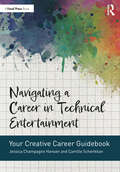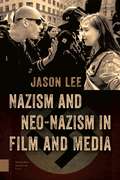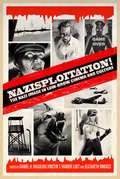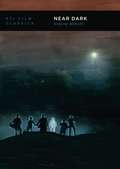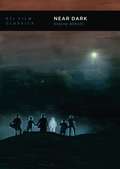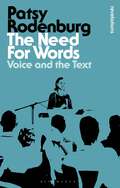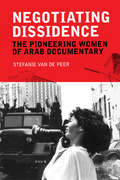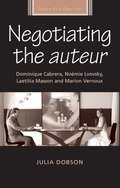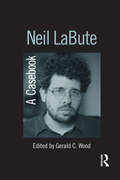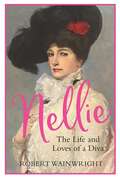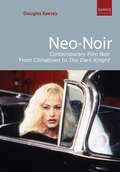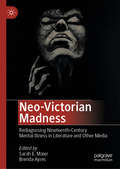- Table View
- List View
Navigating a Career in Technical Entertainment: Your Creative Career Guidebook
by Jessica Champagne Hansen Camille SchenkkanNavigating a Career in Technical Entertainment: Your Creative Career Guidebook explores tools, strategies, and motivational advice from a wide range of industry professionals for navigating an artistic career in design and technology in entertainment. This book is designed to accompany readers every step of the way in their career journey – from landing their first job after school through mid-career pivots and switching industries. It is organized into four parts: Finding Your Career Path; Tools and Strategies for Navigating Your Career Path; Curating a Creative Community as You Sustain Your Career; and Maintaining Flexibility and Finding Fulfillment in Your Career. Filled with motivational advice from mentors in the industry and creative worksheet exercises for personalized career planning, self- reflection, and goal setting, this book demystifies a complex industry, sharing crucial career-related information rarely covered in formal training programs. It explores a wide range of topics, including the types of jobs available in live entertainment and TV/film, education options, job searching, networking, career marketing materials, interviews, unions, financial empowerment, and refocusing on career shifts. This guidebook is written for designers, technicians, stage managers, production managers, crew members, and creative technical artists in entertainment at all stages of their career. Covering a wide variety of entertainment from theater and television to commercials and theme parks, Navigating a Career in Technical Entertainment is a perfect companion for higher education or postsecondary educators and students exploring career and workforce readiness topics and can also be used by professionals actively working in the field. This text also includes access to downloadable versions of the worksheets featured in the book, available at www.routledge.com/9780367510442.
Navigating a Career in Technical Entertainment: Your Creative Career Guidebook
by Jessica Champagne Hansen Camille SchenkkanNavigating a Career in Technical Entertainment: Your Creative Career Guidebook explores tools, strategies, and motivational advice from a wide range of industry professionals for navigating an artistic career in design and technology in entertainment. This book is designed to accompany readers every step of the way in their career journey – from landing their first job after school through mid-career pivots and switching industries. It is organized into four parts: Finding Your Career Path; Tools and Strategies for Navigating Your Career Path; Curating a Creative Community as You Sustain Your Career; and Maintaining Flexibility and Finding Fulfillment in Your Career. Filled with motivational advice from mentors in the industry and creative worksheet exercises for personalized career planning, self- reflection, and goal setting, this book demystifies a complex industry, sharing crucial career-related information rarely covered in formal training programs. It explores a wide range of topics, including the types of jobs available in live entertainment and TV/film, education options, job searching, networking, career marketing materials, interviews, unions, financial empowerment, and refocusing on career shifts. This guidebook is written for designers, technicians, stage managers, production managers, crew members, and creative technical artists in entertainment at all stages of their career. Covering a wide variety of entertainment from theater and television to commercials and theme parks, Navigating a Career in Technical Entertainment is a perfect companion for higher education or postsecondary educators and students exploring career and workforce readiness topics and can also be used by professionals actively working in the field. This text also includes access to downloadable versions of the worksheets featured in the book, available at www.routledge.com/9780367510442.
Nazism and Neo-Nazism in Film and Media (PDF)
by Jason LeeThis timely book takes an original transnational approach to the theme of Nazism and neo-Nazism in film, media, and popular culture, with examples drawn from mainland Europe, the UK, North and Latin America, Asia, and beyond. This approach fits with the established dominance of global multimedia formats, and will be useful for students, scholars, and researchers in all forms of film and media. Along with the essential need to examine current trends in Nazism and neo-Nazism in contemporary media globally, what makes this book even more necessary is that it engages with debates that go to the very heart of our understanding of knowledge: history, memory, meaning, and truth.
Nazisploitation!: The Nazi Image in Low-Brow Cinema and Culture
by Daniel H. Magilow Elizabeth Bridges Kristin T. Vander LugtNazisploitation! examines past intersections of National Socialism and popular cinema and the recent reemergence of this imagery in contemporary visual culture. In the late 1960s and early 1970s, films such as Love Camp 7 and Ilsa, She-Wolf of the SS introduced and reinforced the image of Nazis as master paradigms of evil in what film theorists deem the 'sleaze' film. More recently, Tarantino's Inglourious Basterds, as well as video games such as Call of Duty: World at War, have reinvented this iconography for new audiences. In these works, the violent Nazi becomes the hyperbolic caricature of the "monstrous feminine" or the masculine sadist. Power-hungry scientists seek to clone the Fuhrer, and Nazi zombies rise from the grave.The history, aesthetic strategies, and political implications of such translations of National Socialism into the realm of commercial, low brow, and 'sleaze' visual culture are the focus of this book. The contributors examine when and why the Nazisploitation genre emerged as it did, how it establishes and violates taboos, and why this iconography resonates with contemporary audiences.
Nazisploitation!: The Nazi Image in Low-Brow Cinema and Culture
by Daniel H. Magilow Elizabeth Bridges Kristin T. Vander LugtNazisploitation! examines past intersections of National Socialism and popular cinema and the recent reemergence of this imagery in contemporary visual culture. In the late 1960s and early 1970s, films such as Love Camp 7 and Ilsa, She-Wolf of the SS introduced and reinforced the image of Nazis as master paradigms of evil in what film theorists deem the 'sleaze' film. More recently, Tarantino's Inglourious Basterds, as well as video games such as Call of Duty: World at War, have reinvented this iconography for new audiences. In these works, the violent Nazi becomes the hyperbolic caricature of the "monstrous feminine" or the masculine sadist. Power-hungry scientists seek to clone the Fuhrer, and Nazi zombies rise from the grave.The history, aesthetic strategies, and political implications of such translations of National Socialism into the realm of commercial, low brow, and 'sleaze' visual culture are the focus of this book. The contributors examine when and why the Nazisploitation genre emerged as it did, how it establishes and violates taboos, and why this iconography resonates with contemporary audiences.
Near Dark (BFI Film Classics)
by Stacey AbbottFirst released in 1987, Near Dark is a vampire film set in the contemporary American Midwest that tells the story of Caleb, a half-vampire trying to decide whether to embrace his vampire nature or return to his human family. The film, an early work of the now-established director Kathryn Bigelow, skilfully mixes genre conventions, combining gothic tropes with those of the Western, road movie and film noir, while also introducing elements of the outlaw romance genre.Stacey Abbott's study of the film addresses it as a genre hybrid that also challenges conventions of the vampire film. The vampires are morally ambiguous and undermine the class structures that have historically defined stories of the undead. These are not aristocrats but instead they capture the allure and horror of the disenfranchised and the underclass. As Abbott describes, Near Dark was crucial in consolidating Bigelow's standing as a director of significance at an early point in her career, not simply because of her visual art background, but because of the way in which she would from Near Dark onward re-envision other traditionally mainstream genres of filmmaking.
Near Dark (BFI Film Classics)
by Stacey AbbottFirst released in 1987, Near Dark is a vampire film set in the contemporary American Midwest that tells the story of Caleb, a half-vampire trying to decide whether to embrace his vampire nature or return to his human family. The film, an early work of the now-established director Kathryn Bigelow, skilfully mixes genre conventions, combining gothic tropes with those of the Western, road movie and film noir, while also introducing elements of the outlaw romance genre.Stacey Abbott's study of the film addresses it as a genre hybrid that also challenges conventions of the vampire film. The vampires are morally ambiguous and undermine the class structures that have historically defined stories of the undead. These are not aristocrats but instead they capture the allure and horror of the disenfranchised and the underclass. As Abbott describes, Near Dark was crucial in consolidating Bigelow's standing as a director of significance at an early point in her career, not simply because of her visual art background, but because of the way in which she would from Near Dark onward re-envision other traditionally mainstream genres of filmmaking.
The Need for Words: Voice and the Text (Bloomsbury Revelations)
by Patsy RodenburgAs one of the world's leading voice coaches, Patsy Rodenburg describes practical ways to approach language, using Shakespeare, Romantic poetry, modern prose and a range of other texts to help each of us discover our own unique need for words.In Part One Rodenburg attacks the myth that there is only one correct way to speak by clearing away the blocks that can make language inaccessible. Part Two, a series of language and text exercises, connects the voice to the shape and quality of individual words and phrases. Drawing on Rodenburg's time spent coaching in the worlds of business and politics, this edition reflects on how the way we use words has changed since the book was first published. It brings a renewed focus on the language of power, spoken in the worlds of politicians and company directors. This gives readers an insight into the potency of clear, direct communication. Language and text exercises provide readers with unmediated access to this new research, allowing them to practice and master the language and words that drive the modern world.Foreword by Anthony Sher.
The Need for Words: Voice and the Text (Bloomsbury Revelations)
by Patsy RodenburgAs one of the world's leading voice coaches, Patsy Rodenburg describes practical ways to approach language, using Shakespeare, Romantic poetry, modern prose and a range of other texts to help each of us discover our own unique need for words.In Part One Rodenburg attacks the myth that there is only one correct way to speak by clearing away the blocks that can make language inaccessible. Part Two, a series of language and text exercises, connects the voice to the shape and quality of individual words and phrases. Drawing on Rodenburg's time spent coaching in the worlds of business and politics, this edition reflects on how the way we use words has changed since the book was first published. It brings a renewed focus on the language of power, spoken in the worlds of politicians and company directors. This gives readers an insight into the potency of clear, direct communication. Language and text exercises provide readers with unmediated access to this new research, allowing them to practice and master the language and words that drive the modern world.Foreword by Anthony Sher.
Negotiating Dissidence: The Pioneering Women of Arab Documentary
by Stefanie Van de PeerIn spite of harsh censorship, conservative morals and a lack of investment, women documentarists in the Arab world have found ways to subtly negotiate dissidence in their films, something that is becoming more apparent since the ‘Arab Revolutions’. In this book, Stefanie Van de Peer traces the very beginnings of Arab women making documentaries in the Middle East and North Africa (MENA), from the 1970s and 1980s in Egypt and Lebanon, to the 1990s and 2000s in Morocco and Syria. Supporting a historical overview of the documentary form in the Arab world with a series of in-depth case studies, Van de Peer looks at the work of pioneering figures like Ateyyat El Abnoudy, the ‘mother of Egyptian documentary’, Tunisia’s Selma Baccar and the Palestinian filmmaker Mai Masri. Addressing the context of the films’ production, distribution and exhibition, the book also asks why these women held on to the ideals of a type of filmmaking that was unlikely to be accepted by the censor, and looks at precisely how the women documentarists managed to frame expressions of dissent with the tools available to the documentary maker.
Negotiating Dissidence: The Pioneering Women of Arab Documentary (Edinburgh University Press)
by Stefanie Van de PeerIn spite of harsh censorship, conservative morals and a lack of investment, women documentarists in the Arab world have found ways to subtly negotiate dissidence in their films, something that is becoming more apparent since the ‘Arab Revolutions’. In this book, Stefanie Van de Peer traces the very beginnings of Arab women making documentaries in the Middle East and North Africa (MENA), from the 1970s and 1980s in Egypt and Lebanon, to the 1990s and 2000s in Morocco and Syria. Supporting a historical overview of the documentary form in the Arab world with a series of in-depth case studies, Van de Peer looks at the work of pioneering figures like Ateyyat El Abnoudy, the ‘mother of Egyptian documentary’, Tunisia’s Selma Baccar and the Palestinian filmmaker Mai Masri. Addressing the context of the films’ production, distribution and exhibition, the book also asks why these women held on to the ideals of a type of filmmaking that was unlikely to be accepted by the censor, and looks at precisely how the women documentarists managed to frame expressions of dissent with the tools available to the documentary maker.
Negotiating the auteur: Dominique Cabrera, Noémie Lvovsky, Laetitia Masson and Marion Vernoux (French Film Directors Series)
by Julia DobsonThis book provides the first detailed analysis of the work of four important contemporary directors whose work falls between the reductive labels of 'auteur cinema' and 'popular cinema'. Their work is contextualised within this timely investigation into the shifting relationship between the privileged status of the auteur and questions of genre, gender and cinematic production in France today. This important contribution to understanding the shifting landscapes of contemporary French film identifies an essential intermediacy in the films of these directors, which works to undo a series of dominant oppositions, generic template and contestation, public collectivity and personal intimacy, to offer a new perspective on the location of the political in contemporary French cinema. The four chapters provide detailed critical analysis of films by Dominique Cabrera, Laetitia Masson, Noémie Lvovsky and Marion Vernoux, and present common thread including the possible construction of social intimacy, the political demystification of romance narratives and the role of nostalgia, to argue that their work uses popular genres in order to challenge dominant cultural representation that resonates beyond the immediate parameters of contemporary French cinema. This book will be of interest to researchers working in French and European cinema, to students of Film Studies and French and Francophone Studies, and to film enthusiasts.
Neil LaBute: A Casebook (Casebooks on Modern Dramatists)
by Gerald C. WoodNeil LaBute: A Casebook is the first book to examine one of the most successful and controversial contemporary American playwrights and filmmakers. While he is most famous, and in some cases infamous, for his early films In the Company of Men and Your Friends and Neighbors, Labute is equally accomplished as a playwright. His work extends from the critique of false religiosity in Bash to examinations of opportunism, irresponsible art, failed parenting, and racism in later plays like Mercy Seat, The Shape of Things, The Distance From Here, Fat Pig, Autobahn, and the very recent This Is How It Goes and Some Girls. Like David Mamet, an acknowledged influence on him, and Conor McPhereson, with whom he shares some stylistic and thematic concerns, LaBute tends to polarize audiences. The angry voices, violent situations, and irresponsible behavior in his works, especially those focusing on male characters, have alienated some viewers. But the writer's religious affiliation and refusal to condone the actions of his characters suggest he is neither exploitive nor pornographic. This casebook explores the primary issues of the writer's style, themes, and dramatic achievements. Contributors describe, for example, the influences (both classical and contemporary) on his work, his distinctive vision in theater and film, the role of religious belief in his work, and his satire. In addition to the critical introduction by Wood and the original essays by leading dramatic and literary scholars, the volume also includes a bibliography and a chronology of the playwright's life and works.
Neil LaBute: A Casebook (Casebooks on Modern Dramatists)
by Gerald C. WoodNeil LaBute: A Casebook is the first book to examine one of the most successful and controversial contemporary American playwrights and filmmakers. While he is most famous, and in some cases infamous, for his early films In the Company of Men and Your Friends and Neighbors, Labute is equally accomplished as a playwright. His work extends from the critique of false religiosity in Bash to examinations of opportunism, irresponsible art, failed parenting, and racism in later plays like Mercy Seat, The Shape of Things, The Distance From Here, Fat Pig, Autobahn, and the very recent This Is How It Goes and Some Girls. Like David Mamet, an acknowledged influence on him, and Conor McPhereson, with whom he shares some stylistic and thematic concerns, LaBute tends to polarize audiences. The angry voices, violent situations, and irresponsible behavior in his works, especially those focusing on male characters, have alienated some viewers. But the writer's religious affiliation and refusal to condone the actions of his characters suggest he is neither exploitive nor pornographic. This casebook explores the primary issues of the writer's style, themes, and dramatic achievements. Contributors describe, for example, the influences (both classical and contemporary) on his work, his distinctive vision in theater and film, the role of religious belief in his work, and his satire. In addition to the critical introduction by Wood and the original essays by leading dramatic and literary scholars, the volume also includes a bibliography and a chronology of the playwright's life and works.
Neil Simon: A Casebook (Casebooks on Modern Dramatists)
by Gary KonasFirst Published in 1997.The 16 essays and interviews in this volume explore the background and works of Neil Simon, the most successful playwright in American history. Several of the entries trace Simon's Jewish heritage and its influence on his plays. Although Simon is best known as a writer of a remarkable series of hit Broadway comedies, the contributors to this book have identified a number of "serious" recurring themes in his work, suggesting that a reassessment of the playwright as a dramatist is appropriate. Three interviews with Simon and his longtime producer yield valuable facts about the playwright that will, along with the critical essays, aid the scholar seeking new insights into contemporary American drama in general and Neil Simon in particular.
Neil Simon: A Casebook (Casebooks on Modern Dramatists)
by Gary KonasFirst Published in 1997.The 16 essays and interviews in this volume explore the background and works of Neil Simon, the most successful playwright in American history. Several of the entries trace Simon's Jewish heritage and its influence on his plays. Although Simon is best known as a writer of a remarkable series of hit Broadway comedies, the contributors to this book have identified a number of "serious" recurring themes in his work, suggesting that a reassessment of the playwright as a dramatist is appropriate. Three interviews with Simon and his longtime producer yield valuable facts about the playwright that will, along with the critical essays, aid the scholar seeking new insights into contemporary American drama in general and Neil Simon in particular.
Nellie: The Life and Loves of a Diva
by Robert WainwrightNellie Melba is remembered as a squarish, late middle-aged woman dressed in furs and large hats, an imperious Dame whose voice ruled the world for three decades and inspired a peach and raspberry dessert. But to succeed, she had to battle social expectations and misogyny that would have preferred she stay a housewife in outback Queensland rather than parade herself on stage. She endured the violence of a bad marriage, was denied by scandal a true love with the would-be King of France, and suffered for more than a decade the loss of her only son - stolen by his angry, vengeful father. Despite these obstacles, she built and maintained a career as an opera singer and businesswoman on three continents which made her one of the first international superstars. Award-winning biographer Robert Wainwright presents a very different portrait of this great diva, one that celebrates both her musical contributions and her rich and colourful personal life.
Neo-Feminist Cinema: Girly Films, Chick Flicks, and Consumer Culture
by Hilary RadnerWhat lies behind current feminist discontent with contemporary cinema? Through a combination of cultural and industry analysis, Hilary Radner’s Neo-Feminist Cinema: Girly Films, Chick Flicks and Consumer Culture shows how the needs of conglomerate Hollywood have encouraged an emphasis on consumer culture within films made for women. By exploring a number of representative "girly films," including Pretty Woman, Legally Blonde, Maid in Manhattan, The Devil Wears Prada, and Sex and the City: The Movie, Radner proposes that rather than being "post-feminist," as is usually assumed, such films are better described as "neo-feminist." Examining their narrative format, as it revolves around the story of an ambitious unmarried woman who defines herself through consumer culture as much as through work or romance, Radner argues that these films exemplify neo-liberalist values rather than those of feminism. As such, Neo-Feminist Cinema offers a new explanation as to why feminist-oriented scholars and audiences who are seeking more than "labels and love" from their film experience have viewed recent "girly films" as a betrayal of second-wave feminism, and why, on the other hand, such films have proven to be so successful at the box office.
Neo-Feminist Cinema: Girly Films, Chick Flicks, and Consumer Culture
by Hilary RadnerWhat lies behind current feminist discontent with contemporary cinema? Through a combination of cultural and industry analysis, Hilary Radner’s Neo-Feminist Cinema: Girly Films, Chick Flicks and Consumer Culture shows how the needs of conglomerate Hollywood have encouraged an emphasis on consumer culture within films made for women. By exploring a number of representative "girly films," including Pretty Woman, Legally Blonde, Maid in Manhattan, The Devil Wears Prada, and Sex and the City: The Movie, Radner proposes that rather than being "post-feminist," as is usually assumed, such films are better described as "neo-feminist." Examining their narrative format, as it revolves around the story of an ambitious unmarried woman who defines herself through consumer culture as much as through work or romance, Radner argues that these films exemplify neo-liberalist values rather than those of feminism. As such, Neo-Feminist Cinema offers a new explanation as to why feminist-oriented scholars and audiences who are seeking more than "labels and love" from their film experience have viewed recent "girly films" as a betrayal of second-wave feminism, and why, on the other hand, such films have proven to be so successful at the box office.
Neo-Noir: Contemporary Noir Film From Chinatown To The Dark Knight
by Douglas KeeseyA world- weary detective, a seductive femme fatale, a mysterious murder- these elements of classic film noir live again in more recent hardboiled detective films from Chinatown to Sin City. But the themes and styles of noir have also spilled over into contemporary films about gangsters, cops and serial killers (Reservoir Dogs, The Departed, Se7en). New hybrid genres have been created, including psycho-noirs (Memento), techno-noirs (The Matrix) and superhero noirs (The Dark Knight). Beginning with an introduction that shows how neo-noir has drawn upon contemporary social and historical events as well as the latest technological advances in filmmaking, this book discusses the neo-noir films that have made the biggest splash in the field ('landmarks'), the directors who have become cult figures of neo-noir, ('auteurs'), films from non-English speaking countries ('international') and neo-noirs that put a new spin on past noirs ('remakes'). The main credits and a plot summary are given for each neo-noir, followed by an in-depth analysis containing original insights into the meaning of the film. 'Factoids' also present fascinating facts, behind-the-scenes anecdotes and lively quotes from the cast and crew.
Neo-Noir as Post-Classical Hollywood Cinema
by Robert ArnettNeo-Noir as Post-Classical Hollywood Cinema suggests the terms “noir” and “neo-noir” have been rendered almost meaningless by overuse. The book seeks to re-establish a purpose for neo-noir films and re-consider the organization of 60 years of neo-noir films. Using the notion of post-classical, the book establishes how neo-noir breaks into many movements, some based on time and others based on thematic similarities. The combined movements then form a mosaic of neo-noir. The time-based movements examine Transitional Noir (1960s-early 1970s), Hollywood Renaissance Noir in the 1970s, Eighties Noir, Nineties Noir, and Digital Noir of the 2000s. The thematic movements explore Nostalgia Noir, Hybrid Noir, and Remake and Homage Noir. Academics as well as film buffs will find this book appealing as it deconstructs popular films and places them within new contexts.
Neo-Victorian Madness: Rediagnosing Nineteenth-Century Mental Illness in Literature and Other Media
by Sarah E. Maier Brenda AyresNeo-Victorian Madness: Rediagnosing Nineteenth-Century Mental Illness in Literature and Other Media investigates contemporary fiction, cinema and television shows set in the Victorian period that depict mad murderers, lunatic doctors, social dis/ease and madhouses as if many Victorians were “mad.” Such portraits demand a “rediagnosing” of mental illness that was often reduced to only female hysteria or a general malaise in nineteenth-century renditions. This collection of essays explores questions of neo-Victorian representations of moral insanity, mental illness, disturbed psyches or non-normative imaginings as well as considers the important issues of legal righteousness, social responsibility or methods of restraint and corrupt incarcerations. The chapters investigate the self-conscious re-visions, legacies and lessons of nineteenth-century discourses of madness and/or those persons presumed mad rediagnosed by present-day (neo-Victorian) representations informed by post-nineteenth-century psychological insights.
Neo-Victorian Things: Re-imagining Nineteenth-Century Material Cultures in Literature and Film
by Sarah E. Maier Brenda Ayres Danielle Mariann DoveNeo-Victorian Things: Re-Imagining Nineteenth-Century Material Cultures in Literature and Film is the first volume to focus solely on the replication, reconstruction, and re-presentation of Victorian things. It investigates the role of materiality in contemporary returns to the past as a means of assessing the function of things in remembering, revisioning, and/or reimagining the nineteenth century. Examining iterations of material culture in literature, film and popular television series, this volume offers a reconsideration of nineteenth-century things and the neo-Victorian cultural forms that they have inspired, animated, and even haunted. By turning to new and relatively underexplored strands of neo-Victorian materiality—including opium paraphernalia, slave ships, clothing, and biographical objects—and interrogating the critical role such objects play in reconstructing the past, this volume offers ways of thinking about how mis/apprehensions of material culture in the nineteenth century continue to shape our present understanding of things.
Neo-Victorianism on Screen: Postfeminism and Contemporary Adaptations of Victorian Women
by Antonija PrimoracThis book broadens the scope of inquiry of neo-Victorian studies by focusing primarily on screen adaptations and appropriations of Victorian literature and culture. More specifically, this monograph spotlights the overlapping yet often conflicting drives at work in representations of Victorian heroines in contemporary film and TV. Primorac’s close analyses of screen representations of Victorian women pay special attention to the use of costume and clothes, revealing the tensions between diverse theoretical interventions and generic (often market-oriented) demands. The author elucidates the push and pull between postcolonial critique and nostalgic, often Orientalist spectacle; between feminist textual interventions and postfeminist media images. Furthermore, this book examines neo-Victorianism’s relationship with postfeminist media culture and offers an analysis of the politics behind onscreen treatment of Victorian gender roles, family structures, sexuality, and colonial space.
Neo-Victorianism on Screen: Postfeminism and Contemporary Adaptations of Victorian Women
by Antonija PrimoracThis book broadens the scope of inquiry of neo-Victorian studies by focusing primarily on screen adaptations and appropriations of Victorian literature and culture. More specifically, this monograph spotlights the overlapping yet often conflicting drives at work in representations of Victorian heroines in contemporary film and TV. Primorac’s close analyses of screen representations of Victorian women pay special attention to the use of costume and clothes, revealing the tensions between diverse theoretical interventions and generic (often market-oriented) demands. The author elucidates the push and pull between postcolonial critique and nostalgic, often Orientalist spectacle; between feminist textual interventions and postfeminist media images. Furthermore, this book examines neo-Victorianism’s relationship with postfeminist media culture and offers an analysis of the politics behind onscreen treatment of Victorian gender roles, family structures, sexuality, and colonial space.
